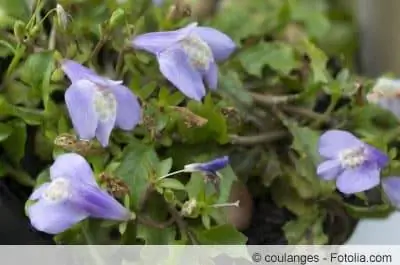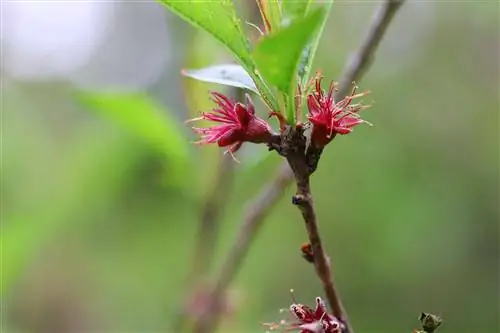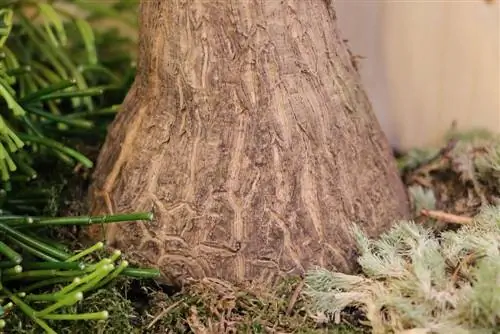- Author admin [email protected].
- Public 2023-12-17 03:39.
- Last modified 2025-01-24 12:45.
If a dense, blue carpet of flowers shines in May, it is the lipped mouth that welcomes spring here. Even the harshest winter doesn't stop the robust ground cover from transforming your garden into a billowing sea of flowers every year. A Mazus reptans does not expect any significant care, because the low-growing perennial comes from the harsh terrain of the Himalayas. Even dry, sandy corners of the garden are given opulent blooms by the graceful juggler flower plant. Take the following care tips to heart so that your lipped mouth can achieve this masterpiece for many years to come.
Profile
- Plant family Phrymaceae
- Title of the species: Lipped Mouth (Mazus reptans)
- Cushion-forming, creeping, herbaceous plant
- Growth height 3-8 centimeters
- Growth width 20-30 centimeters
- Blue-violet flowers from May to July
- Lancelloid to elliptical green foliage
- Hardy and deciduous
The lip-mouth is primarily used as a ground cover. Since it is somewhat resistant to wear and tear, it is sometimes used as a decorative lawn replacement.
Location and soil
In order for the labium to develop the desired compact, dense habitus, it benefits from the following site conditions:
- Sunny to semi-shady location
- Humose, well-drained soil
- Sandy-loamy soil is ideal
The nutrient content is of little relevance to he althy, vital growth. On the other hand, the loose consistency of the bed soil, as it prevails in gravel or rock gardens, is more important. Creative hobby gardeners like to use Mazus reptans as a stylish underplant in pots or flower boxes. In this case, we recommend using commercial potting soil as a substrate, mixed with a few handfuls of sand or perlite. The same applies if the small perennials are used in plant pockets in dry stone walls or gabions.
Care tips
As part of the planting in spring or autumn, the lipmouth receives starter fertilization. Ideally, this consists of a generous portion of compost enriched with horn shavings or an analogous organic fertilizer. Alternatively, a long-term fertilizer provides the young plant with all the important nutrients for the perfect start to perennial life. As a result, freshly planted Mazus reptans must be watered regularly so that the roots can establish themselves well. Equipped with so much vitality, the juggler flower plant only requires a minimum of care as it continues to be cultivated.
- Water the ground cover thoroughly twice a week during summer droughts
- In container culture, watering is carried out regularly, although the substrate should dry out in the meantime
- Starting fertilization in spring meets the nutrient requirements for the entire season
- Cleaning out faded and wilted parts of plants promotes a lush floral bloom
The robust plant accepts a short period of drought without complaint; Nevertheless, it reacts to a lack of water with reduced or irregular growth. Given the solid cutting compatibility, unattractive shoots or cushion segments can be cut off close to the ground at any time with secateurs.
Tip:
Solid fertilizer is difficult to apply to the dense flower cushion. Lipmouths are therefore fertilized with plant manure, liquid compost or a commercially available preparation.
Wintering
Native to the harsh climate of the Himalayan Mountains, the labyrinth is frost-resistant down to -30 degrees Celsius. From this point of view, no specific winter protection is required, at least in the bed. Freshly planted plants are an exception. Before the first frost, they are piled up with leaf mold or covered with straw, brushwood or pine needles. For Mazus reptans with a planter, professional care includes the following precautions to protect against winter weather:
- Place the bucket on a block of wood in front of the protected wall of the house
- Cover the vessel with foil, garden fleece or jute
- Cover the substrate with a layer of leaves, straw, bark mulch or sawdust
- Watering on frost-free days when there is no snow
If you don't feel bothered by the wilted parts of the plant, you should not cut them off until spring. They serve as natural winter protection for the root area. Only immediately before the new shoots are all shoots shortened close to the ground.
Propagate
Anyone who puts down roots in the garden as happily as the lipped mouth naturally awakens the desire for more specimens. Two methods of propagation are available.
Division
Spring or late summer is the right time to propagate Mazus reptans by division. This procedure also makes an important contribution to maintaining the vitality of a flowering plant. Even if no offspring are planned, division is recommended every 3 to 4 years. How to do it right:
- Loosen the soil around the perennial
- Lift the lipped mouth out of the ground with the digging fork or spade
- Using a sharp knife, cut into several segments that have 2-3 buds
- Plant just as deep in the new location and water well
If it is an older plant, division offers a perfect opportunity to cut out stunted parts of the plant. Over the years, unsightly regions develop in the inner circle of the ground cover and are thus rejuvenated.
Sowing
Propagation by sowing is much more complex than division. Since the tiny seeds are cold germinators, they must be subjected to stratification in order to break the germination inhibition. A change in the winter seasons is simulated, combined with a cold stimulus. This variant of breeding is particularly recommended if a large number of young plants are desired, for example to plant the labiate as a lawn replacement. For this purpose, the ripe capsule fruits are collected in autumn and treated as follows:
- Soak the seeds for 24 hours in a 2 percent solution of potassium nitrate (pharmacy)
- Then fill a plastic bag with moist sand and the pre-soaked seeds
- Store in the vegetable compartment of the refrigerator at 0-5 degrees Celsius
- Check the moisture content regularly and keep an eye out for seedlings
When the cotyledons emerge from the seeds, the cold phase is over. Now they are sown in a seed tray with a nutrient-poor substrate, sieved thinly and moistened with water from the spray bottle. Placed in a partially shaded, warm window seat, little lipped mouths develop over the course of the winter. If the seedlings become too crowded in the seed container, it is time to separate them into small pots with commercially available potting soil. During the entire procedure, it is important to ensure that the young plants are neither too dry nor too wet. There is no fertilization during this phase.
Diseases and pests
The resilient Mazus reptans prove to be largely resistant to classic plant diseases when well cared for. However, all their robustness does not protect the little flower wonders from voracious snails. These pests target the tender leaves, especially in spring. Traveling barriers made of sharp materials such as wood chips or grit are an effective defense measure. Regularly sprinkle coffee grounds around the bed, as caffeine has a toxic effect on snails.
Conclusion
Lipmouths create a magical scenario in your garden with dense flower cushions. The sunnier the location, the more lush the growth will be in the pot or flower box on the balcony. Planted in a humus-rich, well-drained substrate with a sandy component, the maintenance effort is quickly reduced to a minimum. Water regularly in dry conditions and a dose of fertilizer in spring are sufficient. If necessary, trim the juggler flowers a little and clean out any withered or faded flowers. The lip-mouths will cheerfully put down roots and catch many an envious glance over the garden fence.






